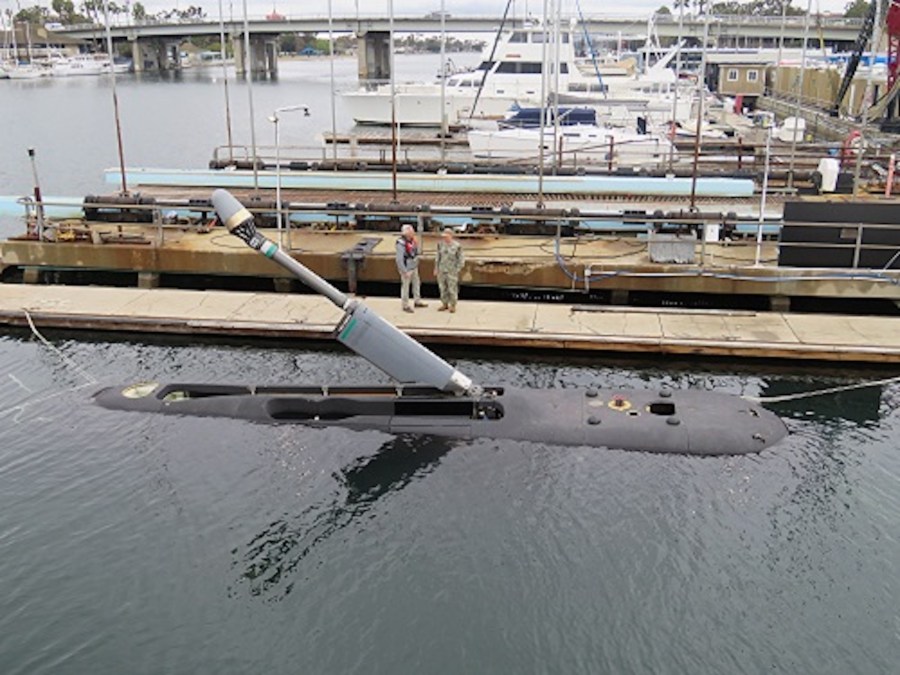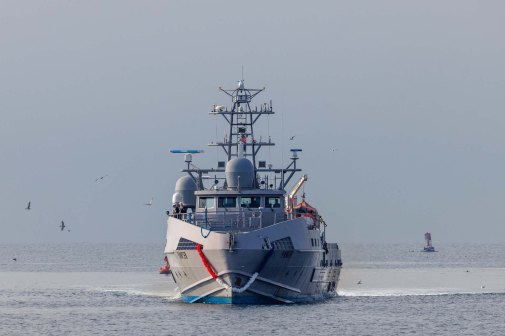What’s next for the Navy’s Orca unmanned submarine?

The Navy is about to put its first jumbo-sized uncrewed submarine out to sea for a series of trials that will be key to the service’s plans for introducing a new type of maritime drone into the fleet.
The Orca unmanned undersea vehicle is an “85 ton, 85-feet-long unmanned diesel-electric submarine. They don’t like me to call it that. It’s an extra-large UUV [XLUUV]. But let’s be honest, it’s 85 tons — it’s an unmanned submarine,” Capt. Scot Searles, program manager for unmanned maritime systems, said during a briefing this week at the Surface Navy Association’s annual symposium.
Boeing delivered the first system to the Navy in December.
The service wants to field a high-endurance undersea drone with a modular payload bay that can travel long distances autonomously and lay mines or perform other missions without putting sailors in harm’s way.
In a statement, Ann Stevens, Boeing’s vice president of maritime and intelligence systems, described the Orca as a “first-of-its-kind capability” for the U.S. military.
The platform went through at-sea testing, including above- and below-surface maneuvers, before the system was delivered last month. But that’s not the end of it.
“Very complex piece of equipment. Very hard work to get where we’re at today … Got it through all of its risk reduction trials and got it delivered. It’s in the Navy’s hands now. It’s down at Huntington Beach [in California] right now, getting ready to go back into the water and continue testing later this month. It’s got 15, 16 more trials planned. So, it’s 16 test periods … focusing on a bunch of different things — obstacle avoidance, just a whole litany of things that it’s got to do [for] mission profiles,” Searles told DefenseScoop at the SNA symposium.
“It’s going to go test every single sensor that was on board, the performance of every sensor that’s on board, and then is it behaving as it needs to in a tactical operating environment? So going beyond just we know all the surfaces work, we know the propulsion works, we drive it around, we can set a new mission [and] it can drive itself autonomously. Check. Now give it to me, now let me go play with it in the real environment. So, all of that’s risk reduction,” he said.
The system that was just delivered is an engineering development model, according to Searles. Boeing is expected to deliver another five vehicles to meet what the Pentagon calls a “joint emergent operational need” (JEON).
“The five JEON vehicles are still on track for delivery at the end of this year. We do have some schedule pressure there. I’ll be completely transparent. You know, it has been a challenge with some of the quality issues we’ve had along the way. We’ve learned a lot. There’s a lot of titanium built into these vessels, and that’s not a forgiving material to work with,” Searles said.
However, “I will tell you … we’re very thrilled with our prime [contractor]. It’s been very aggressive in getting after correcting everything we found. So very happy with how Boeing’s been doing it. I as much as anybody, would have liked to have not had any of those problems. But when you do have them, what you do expect is for industry to go figure it out and fix it. And I would tell you Boeing has done a fantastic job getting after it,” he added.
The first Orca platform, which the Navy has designated XLE0, will be headed out to an operational area off the coast of southern California later this month, according to Searles.
“We’re super excited to have one now in our own hands,” he said.
The design of the platform was inspired by Boeing’s Echo Voyager, which has a range of up to 6,500 nautical miles and can accommodate a modular payload section up to 34 feet in length, as well as external payloads, according to a Congressional Research Service report.
However, the Orca will differ in some respects to meet military requirements, it noted.
The Echo Voyager is 51 feet long and has a weight in the air of 50 tons, according to the CRS report. Searles’ comments about the Orca weighing 85 tons and being 85 feet long seem to indicate that the Navy system is significantly larger than the Echo Voyager.
DefenseScoop asked Rear Adm. Kevin Smith, program executive officer for unmanned and small combatants, when the Orca might be integrated into larger exercises — such as the Integrated Battle Problem series conducted by U.S. Pacific Fleet — or conduct transoceanic voyages like some of the unmanned surface vessel (USV) prototypes that the Navy has been operating.
“The five that we have in production besides the prototype we just launched, they’re going to be delivered in … 24, ’25. So, I can’t really comment per se on some of the stuff that the fleet is going to do. But not long after some of those deliveries, there’s going to start being even more [activity]. You know, still working on the [concept of operations] and all those kinds of things, but you know it’s right on the heels of that,” he said.
Fabrication awards for additional XLUUVs are planned for fiscal 2026, and the service anticipates “gradually ramping up quantities in future fiscal years, depending on the progress from the first five systems,” according to Navy budget documents.
In a keynote speech at the SNA symposium, the new Chief of Naval Operations Adm. Lisa Franchetti said she sees uncrewed systems as a key element of her vision of the future force that will contribute to a broader “warfighting ecosystem.”
Smith, the PEO, specifically mentioned the Orca during a panel at the conference.
“That’s going to bring a lot of capability to the fleet. More players on the field,” he said.






